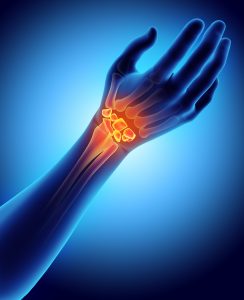Endoscopic Carpal Tunnel Release

WHAT IS CARPAL TUNNEL?
Carpal tunnel syndrome is a common ailment causing hand numbness in middle aged working adults from repetitive motions. Synovium is a lubricating tissue surrounding tendons that easing their movement through the body. The synovium of the flexor tendons of the wrist can become irritated and swell putting pressure on the median nerve as it passes through the wrist into the hand. The pressure on the median nerve interrupts the signaling impulses traveling through the nerve and can cause hand numbness, tingling, and pain. Pain and numbness from compression of the median nerve in the wrist will be expressed in your thumb, pointer finger, middle finger, and part of your ring finger.
WHAT CAUSES CARPAL TUNNEL SYNDROME?
The wrist pain you feel is due to the pressure from the synovium onto the median nerve. The cause of this tissue inflammation can vary but it is an underlying cause of swelling in the wrist which can also obstruct blood flow.
The most common conditions linked to carpal tunnel are diabetes, thyroid dysfunction, high blood pressure, autoimmune disorders such as rheumatoid arthritis, fluid retention, fractures, and trauma to the wrist.
WHAT ARE SYMPTOMS OF CARPAL TUNNEL?
Symptoms are variable depending on the amount of nerve compression. Typically carpal tunnel will generally be expressed with weakness in the hand, pain and burning sensations that may travel up the arm, and numbness or tingling in the thumb, pointer, middle, and ring fingers.
CARPAL TUNNEL DIAGNOSES AND TREATMENT
DIAGNOSING CARPAL TUNNEL
Diagnosing carpal tunnel is typically done by an orthopedic physician, preferably an orthopedic hand surgeon. They will perform a physical examination, discuss patient history, and possibly perform a nerve conduction study or diagnostic test. This works by measuring nerve impulse. If the nerve impulse is slower than normal, it can be an indicator of carpal tunnel syndrome.
ENDOSCOPIC CARPAL TUNNEL RELEASE
In most cases, carpal tunnel surgery is done on an outpatient basis under local anesthesia. During surgery, a cut is made in your palm. The roof (transverse carpal ligament) of the carpal tunnel is divided. This increases the size of the tunnel and decreases pressure on the nerve.
Once the skin is closed, the ligament begins to heal and grow across the division. The new growth heals the ligament, and allows more space for the nerve and flexor tendons.
Some surgeons make a smaller skin incision and use a small camera, called an endoscope, to cut the ligament from the inside of the carpal tunnel. This may speed up recovery.
The end results of traditional and endoscopic procedures are the same. Your doctor will discuss the surgical procedure that best meets your needs.


